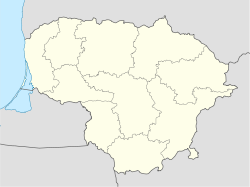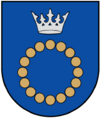Palanga
| Palanga | |||
| — City municipality — | |||
 |
|||
|
|||
| Nickname(s): Vasaros sostinė (Summer Capital) | |||
 Palanga
|
|||
| Coordinates: | |||
| Country | |||
|---|---|---|---|
| Ethnographic region | Samogitia | ||
| County | Klaipėda County | ||
| Municipality | Palanga city municipality | ||
| First mentioned | 1161 | ||
| Granted city rights | 1791 | ||
| Elderships | Šventoji eldership | ||
| Area | |||
| - Total | 79 km² (30.5 sq mi) | ||
| Population (2008) | |||
| - Total | 17,600 | ||
| - Density | 223/km² (577.6/sq mi) | ||
| Time zone | EET (UTC+2) | ||
| - Summer (DST) | EEST (UTC+3) | ||
| Website: http://www.palanga.lt | |||
Palanga () is a seaside resort town in western Lithuania, on the shore of the Baltic Sea. It is the busiest Lithuanian summer resort with sand beaches (18 km long and up to 300 m wide) and dunes.[1] Officially Palanga has the status of city municipality and includes Šventoji, Nemirseta, Būtingė and other settlements, which are treated as part of Palanga city.
Contents |
Myth
According to a legend, there was a pagan shrine at the foot of a hill during the 14th century. That shrine was where a beautiful priestess named Birutė used to light ceremonial fires. Having heard about Birutė, Kęstutis, the Grand Duke of Lithuania, rode over on his horse to take her for his wife. It is written in the Lithuanian Bychowiec Chronicle that Birutė "did not want to agree, and answered that she had promised the gods to guard her virginity as long as she lived. Kęstutis took her by force, and with great honor took her back to his capital of Trakai, where he invited his brothers and threw a big wedding..."[2] After Kęstutis' murder, Birutė returned to Palanga and served the Gods until she died. She is buried in the hill which is now named in her honor.
History
Not far from Šventoji, archaeologists discovered a campground which suggests that the area was inhabited some 5,000 years ago. During the 10th and 11th centuries Palanga had been one of the main settlements of Mēguva Land, inhabited by the Curonian tribe. Situated on the ancient Amber Road, it was the center of trade and crafts.
In historical documents the name of Palanga was first mentioned in 1161 when the King Valdemar I of Denmark disembarked there with his army and captured the castle which was held by the Curonians.
Between the 13th and 15th centuries, the inhabitants of Palanga had to confront the Teutonic Knights in the south and the Livonian Brothers of the Sword in the north. Their adversaries were unable to achieve their goal of seizing the Lithuanian sea-coast from Klaipėda to Šventoji. Although Klaipėda (Memel) passed into the hands of the German feudal lords under the 1422 Treaty of Melno, Palanga and Šventoji remained under Lithuanian control. The two towns gradually developed into harbours and centers of trade. British merchants established enterprises in Šventoji in 1685. During the Great Northern War, the Swedish Army ravaged Palanga, destroyed the harbour at Šventoji, and blocked up the wharfs with rocks in 1701.
Palanga was purchased in 1824 by Count Michał Tyszkiewicz. His grandson Józef Tyszkiewicz built a pier and acquired a ship to transport passengers and bricks to nearby Liepāja. Palanga began to develop as a resort in the early 19th century. The pier has been a favourite spot for strolling and promenading since 1892. Józef Tyszkiewicz's son, Feliks Tyszkiewicz, built thr neo-renaissance Tiškevičiai Palace in 1897. Famous French landscape architect Édouard André designed a large park around the palace, constructed in 1897–1907. The palace became a favourite gathering place for intellectual discussions and concert performances. Prominent among the good friends and advisors of Feliks Tyszkiewicz was the notary, Jonas Kentra.
Following the 1864 Lithuanian press ban, Palanga had become an important point for the smuggling of Lithuanian publications. Rev. Marcijonas Jurgaitis, physician Liudas Vaineikis and Notary Jonas Kentra played leading roles in this action of cultural contraband. With Kentra gaining official approvals, a public gathering in 1899 featured the comedy Amerika pirtyje (America in the Bath) performed in Lithuanian. The Tsarist authorities deported Vaineikis and twenty-five people to Siberia in 1901.[3]
The Tiškevičiai Palace's park was converted into a botanical garden in 1960 and today it has two hundred different types of trees and shrubs, including an oak tree planted by President Antanas Smetona. The palace, now the Palanga Amber Museum, has an extensive collection of amber jewelry and other artifacts. Symphony performances are conducted in the summer, usually in the evening.
Location
Palanga is a resort town through which the Šventoji and Rąžė (Samogitian: Ronžē) Rivers flow into the Baltic Sea. Rąžė was formerly known as Alanga and gave Palanga its name: Palanga literally means on the Alanga River. Palanga municipality extends 24 kilometers from Nemirseta in the south to the Latvian border in the north. Palanga is historically subdivided to Nemirseta, Vanagupė, Kunigiškiai, Manciškiai, and Šventoji – five neighboring fishermen villages which were incorporated into one city after an administrative reform. When Klaipėda Region was part of Germany, Nemirseta was the northernmost village of the East Prussia.
Transportation
Municipality is accessed by roads from Klaipėda and Šiauliai. There are no railroads in the municipality (closest station being in Kretinga, capital of the Kretinga district municipality). Palanga International Airport, second largest in Lithuania, offers good connections to Scandinavian and German cities. Airport is between Palanga and Šventoji, and it offers more flights in summer than winter due to the resort nature of the municipality. It also has rare flights to Vilnius, although due to good roads (A1 highway) it is more viable to travel by car or bus.
Places of interest

During the summer, hordes of tourists descend on Palanga, both for the beach and the seaside carnival centered on Jonas Basanavičius Street, which is a pedestrian thoroughfare during the summer months. There are dozens of restaurants, bars, rides, sideshows, and other entertainment, most featuring bright lights, loud music, and thousands of people on the weekends. The previously-mentioned Amber Museum is located within an extensive botanical garden.
There is one of the oldest still working drugstores in Lithuania, established in the mid-19th century. The city is home to a regional radio station, FM Palanga.
References
External links
|
|||||||||||||||||

